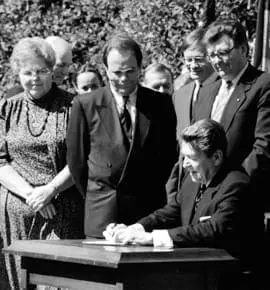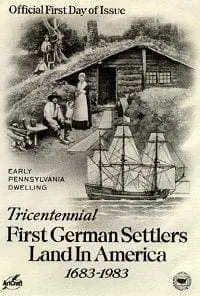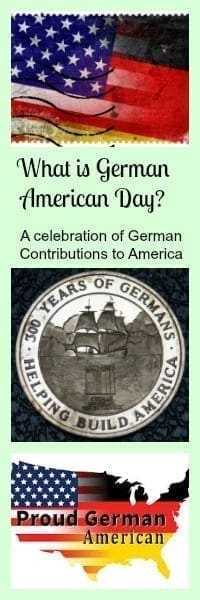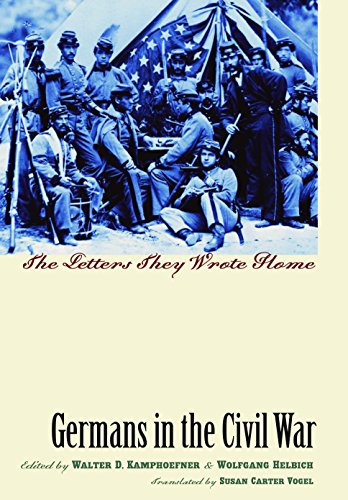October 6th is German American Day in the United States. But what is German American Day? Why do we celebrate it? What is the history of this celebration? And what is the significance of October 6th? German American day has officially been part of the National Calendar since 1987, when Ronald Reagan signed Proclamation 5719 declaring October 6th to officially be known as German American Day. But the significance of German American day goes back much farther than that, all the way to the 1600s when the original 13 German families left Krefeld, and arrived in America, establishing the first German settlement in the new world. Today over 58 million people can claim German ancestry.

President Ronald Reagan signing the first German American Day Proclamation
What Is German American Day?
German American Day celebrates the October 6th arrival of the 13 original German families in America. “German Day” was first celebrated in Philadelphia in 1883, on the 200th anniversary, of that event, to acknowledge the importance of German influence in the area. Later, other surrounding communities held their own “German Day” celebrations. Sadly, World War 1 brought an end to “German Day”, and much of the pride people had in their culture was tucked away for nearly 60 years.
In 1983, 300 years after German colonists arrived in America, and 6 years before the fall of the Berlin Wall, President Ronald Reagan proclaimed that October 6th be known as “German American Day”. By 1987, German-American Day was signed into Law to be an annual event celebrating the achievements and contributions of German Americans.
Proclamation 5917
By the President of the United States of America
A Proclamation
More Americans trace their heritage back to German ancestry than to any other nationality. More than seven million Germans have come to our shores through the years, and today some 60 million Americans — one in four — are of German descent. Few people have blended so completely into the multicultural tapestry of American society and yet have made such singular economic, political, social, scientific, and cultural contributions to the growth and success of these United States as have Americans of German extraction.
The United States has embraced a vast array of German traditions, institutions, and influences. Many of these have become so accepted as parts of our way of life that their ethnic origin has been obscured. For instance, Christmas trees and Broadway musicals are familiar features of American society. Our kindergartens, graduate schools, the social security system, and labor unions are all based on models derived from Germany.
German teachers, musicians, and enthusiastic amateurs have left an indelible imprint on classical music, hymns, choral singing, and marching bands in our country. In architecture and design, German contributions include the modern suspension bridge, Bauhaus, and Jugendstil. German-American scientists have helped make the United States the world’s pioneer in research and technology. The American work ethic, a major factor in the rapid rise of the United States to preeminence in agriculture and industry, owes much to German-Americans’ commitment to excellence.
For more than 3 centuries, Germans have helped build, invigorate, and strengthen this country. But the United States has given as well as received. Just a generation ago, America conceived of and swiftly implemented the Marshall Plan, which helped the new German democracy rise from the rubble of war to become a beacon of democracy in Central Europe. The Berlin Airlift demonstrated the American commitment to the defense of freedom when, still recovering from war, Berlin was threatened by strangulation from the Soviets.
Today, the Federal Republic of Germany is a bulwark of democracy in the heart of a divided Europe. Germans and Americans are rightfully proud of our common values as well as our shared heritage. For more than 3 decades the German-American partnership has been a linchpin in the Western Alliance. Thanks to it, a whole generation of Americans and Europeans has grown up free to enjoy the fruits of liberty.
Our histories are thus intertwined. We now contribute to each other’s trade, enjoy each other’s cultures, and learn from each other’s experiences. The German-American Friendship Garden, which will be dedicated in the District of Columbia in the near future, is symbolic of the close and amicable relations between West Germany and the United States.
The Congress, by Public Law 100 – 104, has designated October 6, 1987, the 304th anniversary of the arrival of the first German immigrants in Philadelphia, as “German-American Day” and has authorized and requested the President to issue a proclamation in observance of that day.
Now, Therefore, I, Ronald Reagan, President of the United States of America, do hereby proclaim Tuesday, October 6, 1987, as German-American Day. I urge all Americans to learn more about the contributions of German immigrants to the life and culture of the United States and to observe this day with appropriate ceremonies and activities.
In Witness Whereof, I have hereunto set my hand this 2nd day of Oct., in the year of our Lord nineteen hundred and eighty-seven, and of the Independence of the United States of America the two hundred and twelfth.
Ronald Reagan
Every year, since 1987, the sitting President of the United States has signed a proclamation declaring October 6th to be German American Day.
History of Germans in America

Image of First German Settlers Land in America 1683-1983 Issued by the Postal Commemorative Society in 1983.
On October 6th, 1683, 13 German Mennonite families from the area around Krefeld in NRW (near Dusseldorf) arrived in Philadelphia in search of freedom from religious persecution, and a fresh start in a new land. They went on to found the city of Germantown, the first German settlement in America. This was just the first wave… over the next 200 years, more and more German families followed, primarily from the states of Baden Wuerttemberg, Hesse, and the Pfalz… but also many from the bishoprics of Cologne, Münster Osnabruck, and Mainz.
Muhlenberg Legend- German as America’s National Language?
There were so many Germans in America, that in the 1840s, the “Muhlenberg Legend” began to circulate in Germany. It stated that German missed out on being the official American Language by just one vote, that of Frederick Muhlenberg, the Speaker of the House. The truth is much less dramatic… It’s based on a petition by the German residents of Augusta County, VA, to have laws printed in German as well as English. While quite a few Germans lived in America, there were no where near enough to force a change of language in the United States. (And more importantly, there IS NO official language of the United States of America). Read more about the Muhlenberg Legend here

Population Density of Germans in America circa 1872- map wikipedia commons
By the 1850s, German immigration was at its peak... over 1 million Germans arrived on American shores escaping the political chaos caused by the 1848 revolutions in Europe. These new arrivals settled in near people who spoke their language, and understood their ways. German Settlements grew, especially in the “German Belt” running through Wisconsin, Minnesota, North Dakota, South Dakota, Nebraska, and Iowa. But German populations also established themselves and grew in Pennsylvania, Ohio, Illinois, Texas and even California.
The Auswandererhaus in Bremerhaven is a FABULOUS place to learn more about German Emigration. Learn more HERE–> Auswandererhaus
German Influences on American Culture and Society
Germans were deeply entwined in the politics of early America. In 1688, only 5 years after arriving, they sent their first petition to the English crown to abolish Slavery. Germans, like Baron von Steuben and Carl Ludwick, fought for American Independance. A German Language Newspaper, “Pennsylvanischer Staatsbote“, was the first American Newspaper to publish the Declaration of Independence for all to read, on July 5, 1776 (the English language papers made it available to the public on July 6th). Later, they became heavily involved in Labor Unions established to insure better working conditions. They heavily influenced the 6 day work week and the 8 hour work day.
But it wasn’t just politics and a strong work ethic. Germans brought with them many traditions that are now deeply woven into the fabric of America. From Holiday customs like the Christmas Tree and the Easter Bunny, to education ideas like Kindergarten and the concept of free primary education for all. Much of what we take for granted in America comes from these early German immigrants.
The first Christmas Trees were introduced to America by the Hessians. Not until the mid 1800s did it become common practice. Photo-University Houston
There were other influences too. Some say that Germans invented the idea of a weekend. Early Americans spent their Sunday observing the Puritan Sabbath, but Germans introduced the “Sunday Outing”. Wherever Germans settled, they established Social Clubs, Singing and Music Clubs, even Recreational Facilities like Bowling Alleys and family Picnic areas in parks. Since Fitness was important, they founded Sports Clubs, and introduced athletics and Gymnastics to the community.
German Americans contributed to music, to architecture, to sciences, and you will even find German influences in the most America of foods… hot dogs and hamburgers.
Germans in America Today
Today, Germans all over America still celebrate their heritage. Children are sent to German School on Saturdays, or immersion schools and camps. There are huge German Fests from Wisconsin to Texas! Cities across America set aside parts of their downtown to host Oktoberfests, and restaurants and breweries are also getting in on the action by hosting weekend parties. German Style Christmas Markets are springing up from Chicago to Washington. Thousands attend or join in on Steuben Parades to honor that famous German American. You can find German Restaurants, Bakeries and Delis in every state of the Union. Being German is suddenly cool again!
The Freistadt Alte Kameraden Band shares the stage with President Reagan at Old Heidelberg Park. 1984 Photo-Dale Blank
Yet despite the connection to Germany and their German Heritage, most German Americans are PROUD and Patriotic citizens of America. They fight in the Military (even when they had to fight the Germans), and help their neighbors when called upon.
What is German American Day? It is a day to celebrate our German heritage. As one of the 58 million Americans who can claim German ancestry, I am proud to do just that.
Want to Learn More About German-American History ??
Here are some great books on the subject.
How German Ingenuity Inspired America: More fun, more Beauty, more Freedom
The German-American Experience Germantown (Images of America)
Germantown (Images of America) German Immigrants in America: An Interactive History Adventure (You Choose Books series) (You Choose: History)
German Immigrants in America: An Interactive History Adventure (You Choose Books series) (You Choose: History) Germans in the Civil War: The Letters They Wrote Home (Civil War America)
Germans in the Civil War: The Letters They Wrote Home (Civil War America) News from the Land of Freedom: German Immigrants Write Home (Documents in American Social History)
News from the Land of Freedom: German Immigrants Write Home (Documents in American Social History)
American Grown with German Roots – Germany Premium T-Shirt “Proud German American” MagnetGermanGirlinAmerica
“Proud German American” MagnetGermanGirlinAmerica














Great in info.
Great info!
One “small detail” that should be added to the story is that Dwight EISENHOWER, the Allied Forces Supreme Commander on D-Day in WWII (and, of course, later President of the United States) was clearly of German descent, his last name being German for “iron hewer”, i.e. meaning “metal worker”. That war was NOT really as much against the country or people of Germany as it was against Hitler’s Nazi regime, and I believe most Americans recognize that, just as “Ike” did.
Doesn’t feel like a small detail to me. Thank you !
GERMANY’S GIFT OF PEACE TO THE WORLDS CHILDREN:
The Worlds Children Peace Monument is an original sculpture conceived during EXPO 2000, the Worlds Fair held in Hannover, Germany by American Cultural Ambassadors David and Renate Jakupca. It was designed and built at the historic ARK in Berea as a project of the International Center for Environmental Arts (ICEA) in cooperation with the United Nations 2000 Culture of Peace Program. The concept of a physical permanent universal symbol of renewal and living peace for all living things utilizing the Theory of Iceality was organized in support of the UN Decade of Peace and Non-Violence for the Children of the World and the United Nations Millennium Development Goals. The incorporation of the rights of flora and fauna in a “Universal Peace Equation” is the first major change in achieving a sustainable global Culture Peace on Earth in over 2000 Years. The WCPM Appraisal is another step forward to nationalizing ‘Great American Peace Trail’, the coast-to-coast trail of WCPM Peace Stones in city parks designed to stop the violence in America’s youth. Full Story Link: http://theicea.com/page33
Are you kidding? After most German cities were totally destroyed. There is evidence that Germany sued for a peaceful resolution, but Allies wanted destruction not resolution. Read Churchill, Hitler and the Unnecessary War by Patrick Buchanan.
Those 13 families might have founded the first German settlement in America, but they certainly weren’t the first Germans in America. My 10th great-grandfather Andries Rees came from Lippstadt, Germany and married his wife Celitje Jans, who was Dutch and whose family had already been in New Amsterdam (New York) a while, in 1651 in NY. So he came here at least no later than 1651.
Thank!!! That’s GREAT info!
Please consider adding Johnny Texas by Carol Hoff to your list of book tittles. It is a children’s book about German immigrant life in Texas. Many elementary teachers read it to their students to introduce Texas history as a classroom subject.
thank you! I will add it. A good friend is Texas German, and he loves to share stories with me.